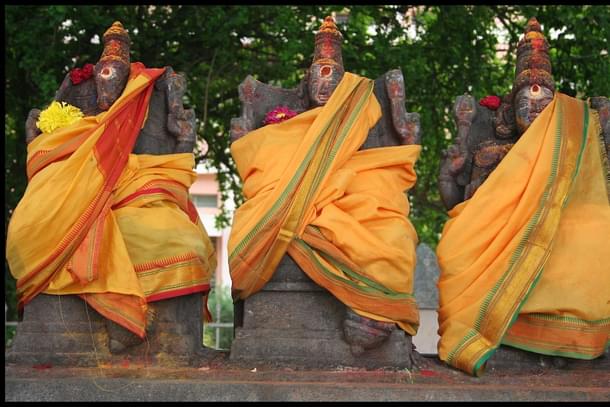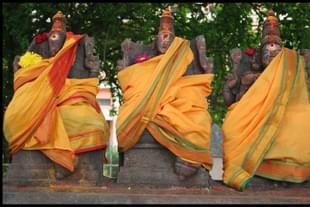Culture
What An Indic Saree Festival Might Look Like And Why Now Is The Best Time To Plan For Its First Edition
Sumati Mehrishi
Oct 07, 2021, 04:17 PM | Updated Oct 08, 2021, 07:12 AM IST
Save & read from anywhere!
Bookmark stories for easy access on any device or the Swarajya app.


It’s 2022 and we are at the ghats of Varanasi. The celebrated duo of maestros Ranjani Gayatri is seated on the dais, draped in off-white, facing the ghats. As always, they wear sarees that correspond to sibling love, colour and collaboration. This time, the border-blouse-saree combinations are in yellows and off-white. They are wearing the Benarasi saree. The recurring motif on their sarees is of the hamsa – the vehicle of Goddess Saraswati. They are in Varanasi to perform for the Saree Utsav.
Far away from Varanasi in southern India, where the vocalist sisters come from, temples draw devotees towards deities who are draped in the local weaves. Peela drapes Ganapati, Mahadev and Parvati.
It's a rough, imagined surface picture of the Saree Utsav that India needs in order to connect the celebration of saree with temple life and the life of weavers.
The ghats begin to fill. The sister-vocalists sing Hamsadhwani. The women of Varanasi dot the steps, appearing like strings of peeli guldaudi — yellow chrysanthemum — as they are all dressed in yellow sarees. The message of the Saree Utsav has reached the home and heart of the true and ordinary Indic woman. The camera lenses slowly fall on the motif of their sarees.
Tourists for the first time get the glimpse of the rich and humble collection of sarees that the locals have for generations. In the galees of Benaras, spreads the bustle of Bharat. Basant is prompting the saree stores to become the bee hives of the celebration of silk.
The images are beamed over to saree weavers across India, and the world watches as each weaver’s contribution of his five best sarees in peela is featured at the saree festival. Wearing them is a local, a pilgrim, a well-known artiste of the performing arts, a front line worker, a student, a seller of flowers…
For the next 10 days, the Benarasi saree will be the only garment that women will wear to the ghats and temples as ragas, shehnai, Dhrupad and the arts converge to the temple town. Swarajya has exclusive media rights to the saree utsav and in summer, it will go south, to Udupi, for the Udupi saree utsav.
Now, you might say that the saree IS already part of the devotees' cultural and devotion-driven response to temples. Many and most women devotees turn up at temples for worship wearing a saree itself and that's enough as an assertion of identity, garment, roots, weave, colour.
I would say, yes, but we can do much more.
Saree Utsav In Purpose
What should a saree festival achieve?
One. Economic success. The saree will begin to be the reason and the propeller for helping local economy improve.
It will come when people who understand cultural perspectives and the grassroot work curate it and work with people who understand returns. Even a Rs 200 saree should find the eyes it deserves. A woven piece priced at Rs 20,000 should find the eyes and the sighs to audience pan India.
It will come when the weaver is brought to the forefront. The curation of ideas in the saree festival will make the weaver see that appreciation for the detail in his work is finally in place, and in sales.
It will come when the jajmaan and devotee also become the patron and buyer who probably will now link the saree with the pilgrimage in a more enthusiastic and emotional manner. His involvement and time spent there will naturally help other small businesses in the locality/town earn his presence.
Two: Celebration of the Indic woman. The ordinary Indic woman. Imagine the woman flower sellers connected to temple life somewhere in Tamil Nadu walking towards the temple dressed in the ten sarees woven in that hub — at a specially arranged facet of the saree utsav. The nadhaswaram plays inside the temple and the saxophone outside in the background.
Business moving, proposals being typed faster, collaborations weaving stronger. Locals notice the change in linking the celebration of the saree with the temples and temple life.
Three: the essential pairing with the performing arts, motif, temple architecture, folk arts and music, local music ensembles.
Four: Dismantling of Western notions and film-industry-fed notions on the saree in urban India. The brilliant response of the Indic woman to the saree festival can wipe all the 'unsmart' confusion on what’s “smart”, “formal” “in” “acceptable” “cool” “dressy”.
Five: An utsava of the traditional draping styles across regions and the building of their acceptance in “modern” daily lives. Remember this article on the seedha palla? How many draping styles live in your state alone?
Six: Making temples the reason, the aesthetic guide, the philosophy, the point of identity, convergence point, the receiver of the celebration of the saree and hence uplifting the temple economy.
Begin from Benaras
Varanasi is the world renowned centre for saree weaving, and there is no better time than now for making a 'saree utsav' emerge from it ghats. Also, there is perhaps no better ground than UP, currently, to initiate a saree utsav in weaving hubs in order to connect them with temple life.
Navaratra worship traditions — the central point
Navaratra, the worship and the celebration of the Devi, is here. Many of us may want to drape ourselves in the festivities and saree, over the nine days and nights, to feel one with the Devi. Will we ever return to a world where temples, the Devi, our festivities with the celebrations of the saree met the Navaratras — and in the same vigour as pre-Covid? These recurrent questions were appearing in my head when a private message popped on a social media site.
"Please send me your postal address," it said. The sender is a saree lover, a temple goer, a bhakta with an ear for classical music and feet for travelling, love for the handwoven. A lot in common there. In the next message she sent a picture with two vibrant sarees and a tag carrying the photograph of an elderly weaver — Shri Kutti Shettigar.
"Will break the suspense because I would want you to choose the one you like," she wrote along with the picture. A woman living in Uttarakhand is about to receive a saree from Karnataka — by post. These are simple Dharmic sisterhood things of which the saree is an important thread.
This very emotion for the saree can turn things around for temple life now and in the post Covid scenario — effectively and in a vibrant way. Now imagine if the traditional gifting during the Navaratras is linked to temple life and the saree weavers' fraternity. It gives 18 days in a year of vibrant celebrations around worship of the Devi and rituals.
There are several points of excitement here besides receiving a saree as a Navaratra gift from (let's call her) Madam V.
Madam V comes with an eye for weaver lives and challenges they face. She comes with a deep perspective on culture and love for travel and storytelling. Now if 1,000 more ordinary women like her, pan India, put brains together to the process of connecting saree and temple life with the help of a saree festival, there would be an eruption of brilliant ideas and their execution.
Stop Wasting Energies On Urban Hashtags, Turn To Temples
Currently, there are women helping weavers scale up their sales by connecting the weavers to buyers via various social media platforms to help the weaver fraternity beat Covid-related dips in sale. There was the 100 saree pact, moving towards its peak a few years ago. There are saree-sisterhoods flourishing on Facebook (where women connect over saree selfies and club it with awareness on weavers). However, these efforts have seen weavers losing out in some aspects (the issue of saree being brought in bulk for not a satisfactory price has been pointed out and comes up).
Then, the weaver stays in the background.
Then, the temple and temple life are not even figuring anywhere.
Last month, social media erupted with another campaign in favour of the saree. Women posted their loveliest pictures (when do they not). It was prompted by an incident at a Delhi restaurant. In the love for the saree women posted much poetry and colour. Many of these beautiful sarees posted by users of social media were handwoven. Saree doesn’t need validation and campaign. Attention going to urban business spaces can be diverted to a meaningful destination.
This author doesn't make much of such campaigns. They have limitations other than being selfie, oops, self-driven. The fervour needs to go real — outside the virtual.
Involving the True Indic Icon
In 2007, I got my interview appointments with two world renowned vocalists pursuing Hindustani music who were visiting Chennai to perform at a festival. One was coming from Maharashtra and the other from Madhya Pradesh — both rich in saree heritage and weave hubs. When I reached the hotel lobby, I got to know that they were out to
shop. Sarees — what else!
I received a phone call from one of them saying they would be late by at least 30 minutes as they were caught in saree shopping. They returned with fat paper bags in all four hands. Both were profusely apologetic, giggling sheepishly as I smiled looking at how much they had shopped. That and that much is normal for anyone who loves sarees and T Nagar. Chennai gets its sarees not only from rich weave hubs in states in southern India, but from across India.
This sweet incident gave me a unique glimpse to Chennai's own contribution as a host to the Margazhi festival and allied cultural activities to the silk saree industry. What is certain is the fact that the same or similar experience as I had with these two maestros would be possible in Benaras, or Guwahati or Kota.
Remember the iconic picture of the scientists draped in saree who sent Mangalyaan to Mars? The Indic woman is herself the best validation of the saree, the draping and their mark on beauty, belief, achievement and devotion.
The Intergenerational Flow
The saree festival will prompt an intergenerational flow of narratives. I am not talking about the granny to grand-daughter flow of the saree alone. I am talking about the projection of saree as a “garment” for the teenage Instagram-influenced generation in respect with their familial bond — with the temple as the central emotional force. Saree can go on to play a special role in their visiting temple with their elders as well as their friends.
The Instagram generation: come on in, towards the temple-life, in a pallu on shoulder with straight denim top or stole-fashioned pleated pallu round the neck, skirt — chunari style drape. Meet the weaver, kishori (teenager), Instagram-story the weaver with his permission or request, pick his sales as your cause or project, ask him if you would like to take ideas for exclusive weave or motif for your BFF bunch, or for your cousin cavalcade. And all this happens when you are in a temple town hub which is also a saree hub — encouraging small businesses there.
Saree utsav as the provocateur of change should see the spotlight falling on weavers and women as drapers, buyers and patrons. The connection women weave between the weaver and temple life as temple goers will be unparalleled once the passion for it involves and awakens every woman. The rituals and sanctity are central to temple life. The saree wrap in and curtain them from erosion-threats.




